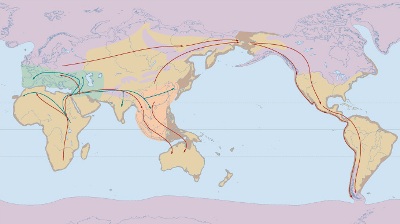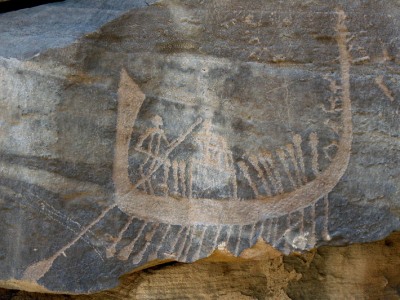
Walk, walk...

The anatomically modern man (our species, also known as sapiens sapiens ) appeared in the Horn of Africa towards the end of the penultimate ice age, about 130,000 years ago 1 (Stringer, 2000). In the following interglacial period, the first migrations (probably due to desertification in the Horn of Africa) led men on the shores of the Red Sea, where they began to eat fish and seafood, and used for the first time obsidian (Walter et al., 2000). The penultimate interglacial period lasted about 12,000 years (Bard et al., 2002) and then, during the following Ice Age (the last one), migrations resumed towards Eurasia and South Africa, at least according to the most accepted model (Stringer, 2002).

The art of navigation seems to be born in the middle of the last ice age. Man proved to be able to navigate at least 50,000 years ago, colonizing Australia via sea (Stringer, 2002). In the Mediterranean, the earliest proofs of seafaring date back to about 30,000 years ago, because, even in a rudimentary form, it was necessary either to colonize the islands (the first settlements in Sicily inply crossing the Strait of Messina before that date) or to fish (remains of large fish, dated 28,000 years ago, are present in the cave Üçagizli in Turkey) (Greaves and Helwing, 2003).
[1] Some recent findings, partially controversial, would push this date to 200,000 years ago, close to the appearance of Neanderthal man who appeared about 250,000 years ago and extinguished about 30,000 years ago.
Bard E., Antonioli F. and Silenzi, S. (2002) Sea-level during the penultimate interglacial period based on a submerged stalagmite from Argentarola Cave (Italy) Earth Planet. Sci. Lett. 196, 135-146.
Greaves A.M., B. Helwing, “Archaeology in Turkey: the stone, Bronze and Iron Age, 2000”, in AJA 107/1, pp. 71-103.
Stringer, Chris (2000) Coasting out of Africa. Nature 405, 24-26.
Stringer, Chris (2002) Modern human origins: progress and prospects. Phil. Trans. R. Soc. Lond. B 2002 357, 563-579.
Walter, Robert C., Richard T. Buffler, J. Henrich Bruggemann, Mireille M. M. Guillaume, Seife M. Berhe, Berhane Negassi, Yoseph Libsekal, Hai Cheng, R. Lawrence Edwards, Rudo von Coselk, Didier Neraudeau & Mario Gagnon (2000) Early human occupation of the Red Sea coast of Eritrea during the last interglacial. Nature 405, 65-69.
Dal 2012 ci sono stati accessi al sito; Atlantide č stata visitata volte.